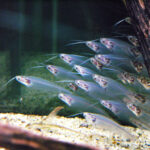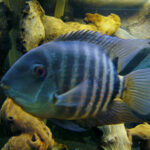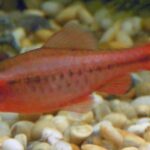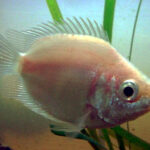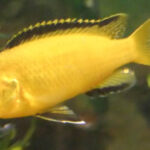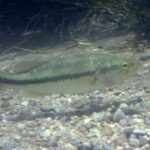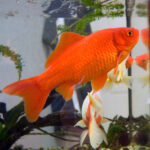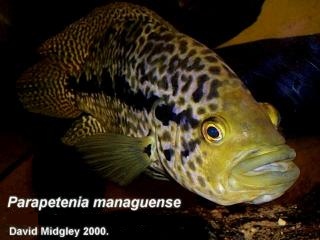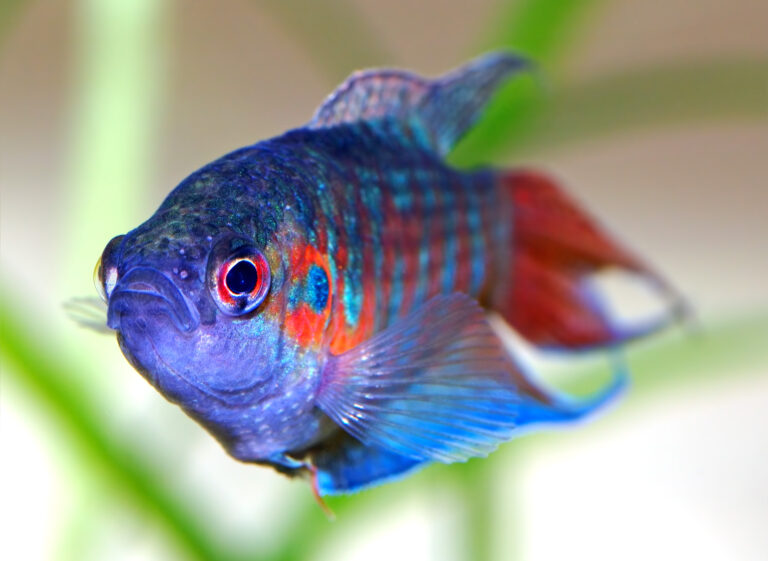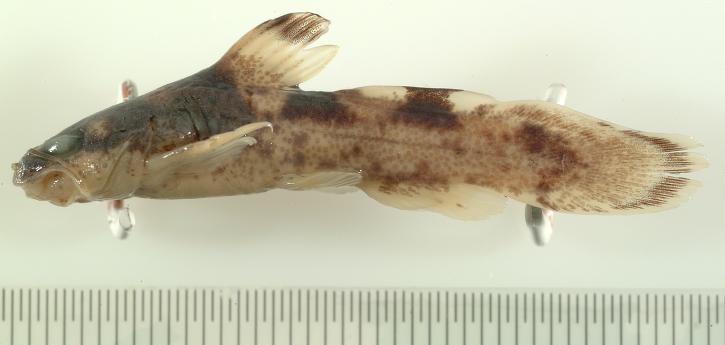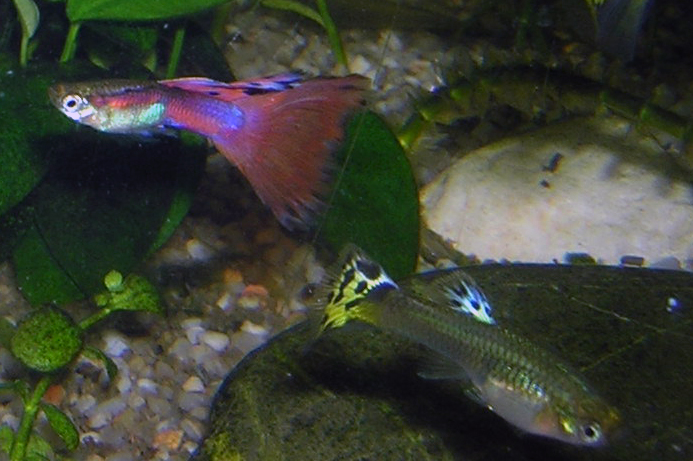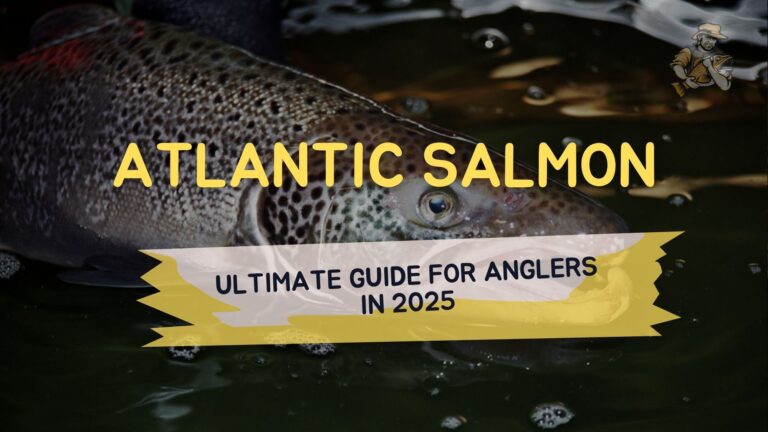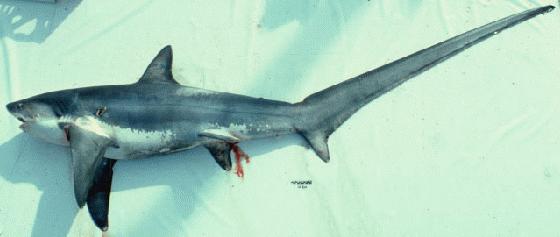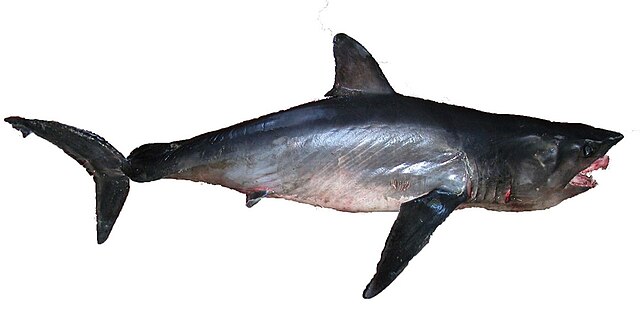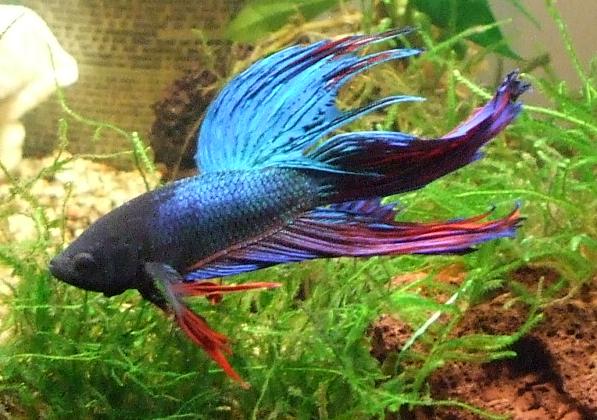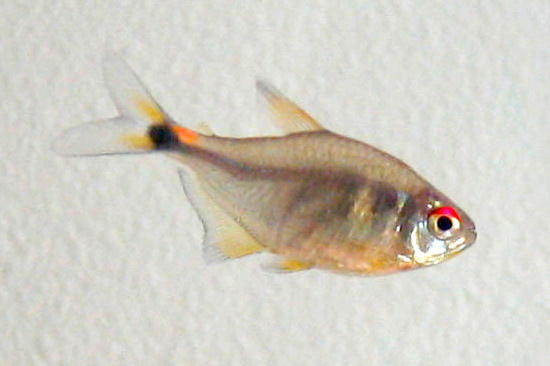Giant Gourami
By Ryan Maron | Last Modified: June 10, 2025
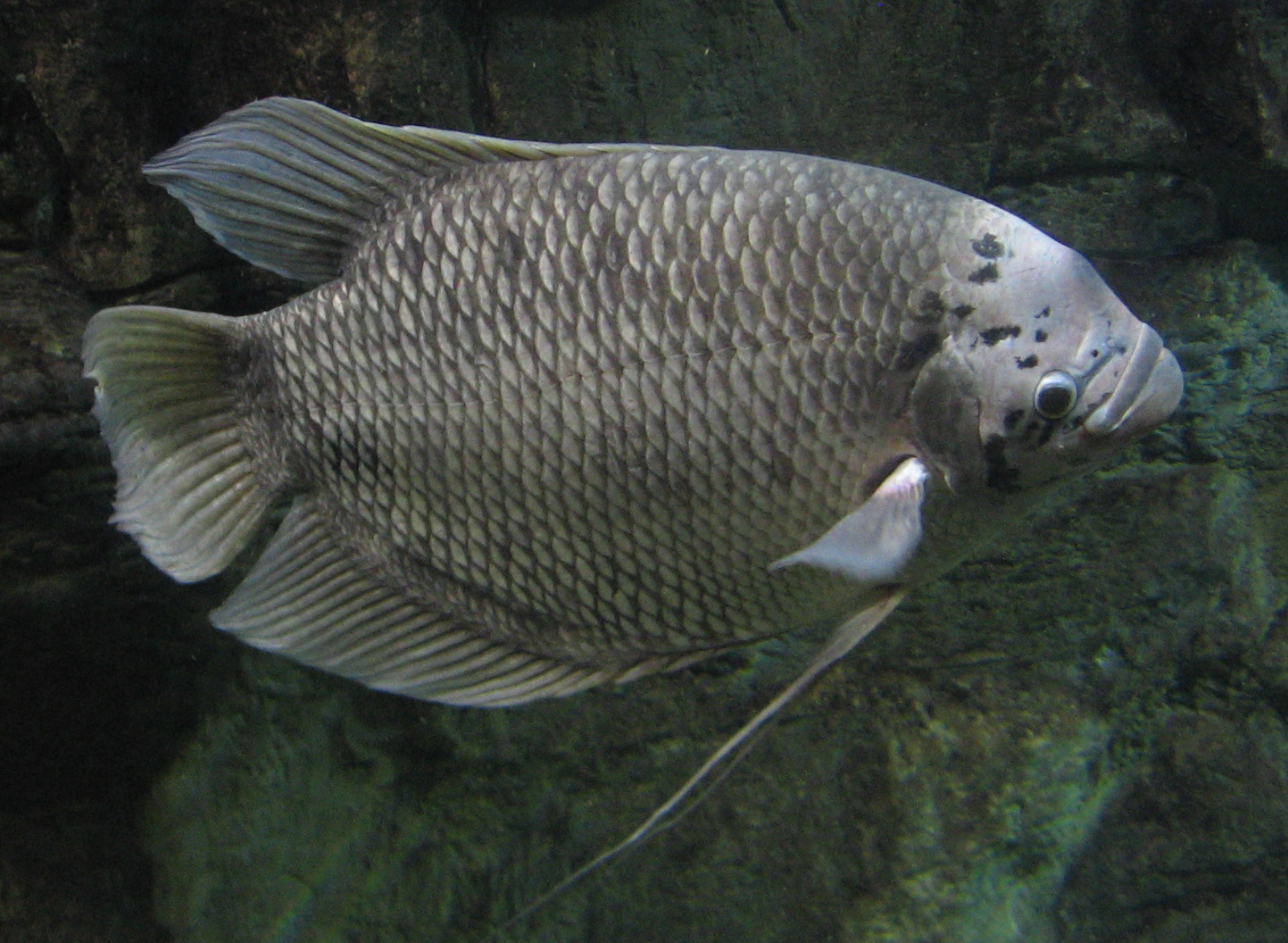
The Giant Gourami (Osphronemus goramy) represents one of the most remarkable freshwater fish species in Southeast Asia, distinguished by its impressive size, complex social behaviors, and significant cultural importance throughout its native range. As the largest member of the gourami family, this species can reach lengths exceeding 70 centimeters and weights of up to 9 kilograms, making it a formidable presence in both natural ecosystems and aquaculture operations. The Giant Gourami plays a crucial ecological role as both predator and prey within freshwater food webs, while simultaneously serving as a vital protein source for millions of people across tropical Asia. Its labyrinth organ adaptation allows survival in oxygen-depleted waters, positioning this species as a keystone organism in slow-moving rivers, flooded forests, and constructed wetlands where other large fish cannot thrive.
| Feature | Details |
|---|---|
| Common Name | Giant Gourami |
| Scientific Name | Osphronemus goramy |
| Family | Osphronemidae |
| Typical Size | 45-70 cm (18-28 in), 4-9 kg (9-20 lbs) |
| Habitat | Slow-moving rivers and flooded forests |
| Diet | Omnivorous – plants, insects, small fish |
| Distribution | Southeast Asia, introduced globally |
| Conservation Status | Least Concern |
Taxonomy & Classification
The Giant Gourami belongs to the family Osphronemidae, which encompasses all true gouramis and represents one of the most evolutionarily advanced groups of freshwater fish in Southeast Asia. First scientifically described by Lacepède in 1801, Osphronemus goramy has undergone several taxonomic revisions as molecular analysis has revealed the complexity of gourami relationships. The genus Osphronemus currently includes four recognized species, with O. goramy serving as the type species and most widely distributed member.
Within the broader classification system, Giant Gouramis are part of the suborder Anabantoidei, commonly known as labyrinth fish due to their specialized respiratory organ. This taxonomic group includes bettas, paradise fish, and climbing perch, all sharing the remarkable ability to breathe atmospheric oxygen directly. The family Osphronemidae is distinguished from other anabantoid families by their larger adult size, complex nest-building behaviors, and specialized feeding structures adapted for processing both plant and animal matter.
Recent phylogenetic studies have confirmed that Osphronemus represents an ancient lineage within the gourami family, having diverged from other osphronemid genera approximately 20-25 million years ago during the Miocene epoch. This evolutionary history explains the Giant Gourami’s unique combination of primitive and advanced characteristics, including its robust body plan and sophisticated parental care behaviors.
Physical Description
The Giant Gourami exhibits a distinctive compressed, oval-shaped body profile that maximizes swimming efficiency in slow-moving waters while providing ample space for the enlarged swim bladder and labyrinth organ. Adult specimens typically measure 45-70 centimeters in total length, though exceptional individuals can exceed 75 centimeters and weigh over 9 kilograms. The species displays pronounced sexual dimorphism, with mature males developing more pointed dorsal and anal fins, brighter coloration, and distinctive breeding tubercles on the head and gill covers.
Coloration varies significantly with age, habitat, and breeding condition. Juvenile Giant Gouramis display alternating dark and light vertical bands across their silvery bodies, providing effective camouflage among aquatic vegetation. As fish mature, these bands typically fade to reveal a more uniform golden-brown to olive-green base coloration, often with darker mottling across the back and sides. During spawning periods, both sexes intensify in color, with males showing particularly vibrant orange and red hues on the fins and lower body regions.
The species possesses several distinctive anatomical features that facilitate its ecological niche. Large, forward-facing eyes provide excellent vision for detecting both prey and predators in murky water conditions. The mouth is relatively small but highly protrusible, allowing precise capture of individual food items ranging from algae to small invertebrates. Modified thread-like pelvic fins serve as tactile organs for exploring substrate and vegetation, while the characteristic labyrinth organ enables survival in oxygen-poor environments that exclude most other large fish species.
Habitat & Distribution
Giant Gouramis naturally inhabit the freshwater systems of Southeast Asia, with their native range extending from the Mekong River basin through Thailand, Cambodia, Vietnam, and southern China, south through peninsular Malaysia and the Indonesian archipelago. The species shows particular affinity for slow-moving rivers, oxbow lakes, flooded forests, and seasonal wetlands where water temperatures remain consistently warm between 24-30°C throughout the year.
Within these aquatic ecosystems, Giant Gouramis typically occupy areas with abundant aquatic vegetation, submerged logs, and overhanging terrestrial plants that provide both food resources and shelter from predators. The species demonstrates remarkable tolerance for poor water quality conditions, thriving in environments with low dissolved oxygen levels, high turbidity, and fluctuating pH levels that would stress most other large freshwater fish. This adaptability stems largely from their labyrinth organ, which supplements gill respiration by extracting oxygen directly from atmospheric air.
Human activities have dramatically expanded the Giant Gourami’s global distribution through both intentional introductions for aquaculture and accidental releases from fish farms. Established populations now exist throughout tropical and subtropical regions worldwide, including parts of Australia, the Caribbean, Central America, and various Pacific islands. In many of these introduced ranges, Giant Gouramis have become important components of local fisheries while occasionally raising concerns about impacts on native fish communities. Water temperature appears to be the primary limiting factor for establishment, with populations unable to persist where winter temperatures regularly drop below 18°C.
Diet & Feeding Behavior
The Giant Gourami exhibits opportunistic omnivorous feeding behavior that shifts significantly throughout different life stages and seasonal cycles. Juvenile fish initially focus on zooplankton, small insects, and algae, gradually incorporating larger prey items as their gape size increases. Adult Giant Gouramis consume a diverse array of food sources including aquatic plants, fruits, seeds, insects, crustaceans, mollusks, and occasionally small fish, making them important ecosystem engineers in their native habitats.
Plant matter typically comprises 60-70% of the adult diet, with particular preference for soft aquatic vegetation, submerged fruits, and decomposing organic material. The species plays a crucial role in seed dispersal for many riparian and aquatic plants, as viable seeds pass through their digestive system and are deposited in new locations. During peak fruiting seasons, Giant Gouramis often congregate beneath overhanging trees to feed on fallen fruits, demonstrating sophisticated foraging strategies that maximize energy intake.
Feeding behavior varies dramatically with water levels and seasonal patterns. During dry seasons when prey density increases in contracted water bodies, Giant Gouramis shift toward more carnivorous feeding, actively pursuing fish, amphibians, and large invertebrates. Their protrusible mouths and powerful pharyngeal mills enable processing of hard-shelled prey like snails and freshwater mussels. The species exhibits crepuscular feeding patterns, showing peak activity during dawn and dusk hours when many prey species are most vulnerable. This feeding strategy, combined with their ability to survive in low-oxygen conditions, allows Giant Gouramis to exploit ecological niches unavailable to many competing fish species.
Behavior & Adaptations
Giant Gouramis demonstrate complex social behaviors that vary significantly with life stage, population density, and environmental conditions. Juvenile fish often form loose aggregations in shallow, vegetated areas where they benefit from reduced predation risk and enhanced foraging opportunities. As individuals mature, territorial behaviors become increasingly pronounced, particularly among males during breeding seasons when aggressive interactions determine access to prime nesting sites and potential mates.
The species’ most remarkable adaptation is the labyrinth organ, a specialized respiratory structure that allows direct extraction of oxygen from atmospheric air. This evolutionary innovation enables Giant Gouramis to survive in seasonally hypoxic waters, temporary pools, and even brief periods out of water during habitat transitions. Individuals regularly surface to gulp air, particularly during warm periods when dissolved oxygen levels decline. The labyrinth organ also facilitates survival in shallow, vegetation-choked waters where gill respiration alone would be insufficient.
Giant Gouramis exhibit sophisticated spatial memory and navigation abilities, often returning to specific feeding areas, shelter sites, and breeding territories across considerable distances. During flood seasons, individuals may travel several kilometers from their dry-season refugia to exploit newly available foraging areas in flooded forests and grasslands. The species demonstrates remarkable problem-solving capabilities in laboratory settings, quickly learning to navigate complex mazes and respond to environmental cues. These cognitive abilities likely contribute to their success as both wild fish and aquaculture subjects, as they can adapt behavioral strategies to changing environmental conditions and human management practices.
Reproduction & Life Cycle
Giant Gourami reproduction follows a complex seasonal pattern closely tied to monsoon cycles and water level fluctuations throughout their native range. Breeding typically occurs during rising water periods when flooded vegetation provides abundant nesting materials and food resources for developing larvae. Sexual maturity is reached at approximately 2-3 years of age, corresponding to body lengths of 25-35 centimeters, though growth rates vary significantly with environmental conditions and food availability.
The reproductive process begins with elaborate courtship behaviors as males establish breeding territories in shallow, heavily vegetated areas. Males construct large floating bubble nests measuring 30-50 centimeters in diameter, incorporating plant materials, foam, and saliva to create stable platforms for egg incubation. Nest construction can require several days, with males meticulously arranging vegetation and maintaining optimal bubble density to ensure proper oxygenation for developing embryos.
Spawning occurs through multiple embrace sequences where the female releases 3,000-8,000 buoyant eggs that float to the nest surface. Males immediately collect and arrange eggs within the bubble nest structure, then assume sole responsibility for parental care throughout the 3-4 day incubation period. Newly hatched larvae remain attached to the nest for an additional 4-5 days until their yolk sacs are absorbed and they begin free-swimming. Male parental care continues for 2-3 weeks post-hatching, with guardian males actively defending fry schools from predators and guiding them to productive foraging areas. This extended parental investment significantly improves juvenile survival rates compared to fish species that provide no post-spawning care, contributing to the Giant Gourami’s success across diverse environmental conditions.
Predators & Threats
Adult Giant Gouramis face relatively few natural predators due to their large size and defensive capabilities, though several species pose significant threats throughout different life stages. Large predatory fish including snakeheads, catfish, and pike-cichlids actively hunt juvenile and sub-adult gouramis in shared habitats. Crocodilians represent the primary predator of adult Giant Gouramis in many river systems, while large water birds such as herons and cormorants frequently target smaller individuals in shallow water areas.
Eggs and larvae face intense predation pressure from diverse aquatic organisms despite male parental care. Small fish, aquatic insects, amphibians, and even conspecific adults readily consume gourami eggs when nests are left unguarded. The bubble nest structure provides some protection by elevating eggs above benthic predators, but surface-feeding species including killifish and certain cyprinids pose persistent threats during the vulnerable early development period.
Human activities represent the most significant contemporary threat to Giant Gourami populations throughout their native range. Habitat destruction through dam construction, wetland drainage, and agricultural conversion has eliminated millions of hectares of prime gourami habitat across Southeast Asia. Water pollution from industrial discharge, agricultural runoff, and urban development degrades remaining habitats and reduces prey availability. Overfishing pressure in some regions has led to local population declines, particularly where Giant Gouramis are heavily exploited for both subsistence and commercial purposes. Climate change poses emerging challenges through altered precipitation patterns that disrupt traditional breeding cycles and modify the seasonal flooding regimes upon which successful reproduction depends. However, the species’ adaptability and continued importance in aquaculture help maintain stable global populations despite these localized pressures.
Conservation Status
The International Union for Conservation of Nature (IUCN) currently classifies the Giant Gourami as Least Concern, reflecting the species’ wide distribution, stable population trends, and successful adaptation to human-modified environments. This classification recognizes that while localized threats exist throughout the native range, overall population numbers remain robust due to the species’ ecological flexibility and continued propagation through aquaculture operations.
Regional conservation assessments reveal more nuanced population dynamics across different portions of the Giant Gourami’s range. Some river systems in Thailand and Vietnam have experienced notable population declines due to habitat modification and fishing pressure, leading to local conservation initiatives focused on habitat restoration and fishing regulations. Conversely, introduced populations in regions like Australia and the Caribbean continue expanding their ranges, sometimes requiring management interventions to prevent ecological impacts on native species.
Current conservation efforts primarily focus on habitat protection and sustainable fisheries management rather than species-specific recovery programs. Several Southeast Asian countries have established protected areas that encompass critical Giant Gourami spawning and nursery habitats, while aquaculture programs help reduce fishing pressure on wild populations by providing alternative protein sources. The species’ success in captive breeding programs ensures that genetic diversity can be maintained even if wild populations face future challenges. Research priorities include better understanding of population connectivity between river systems, quantifying the ecological impacts of introduced populations, and developing more sustainable aquaculture practices that reduce environmental risks while supporting local communities that depend on Giant Gouramis for food security.
Human Interaction
Giant Gouramis have maintained profound cultural and economic importance throughout Southeast Asia for over a millennium, serving as both a primary protein source and a symbol of abundance in many traditional societies. Archaeological evidence suggests that indigenous communities were successfully managing Giant Gourami populations through seasonal fishing restrictions and habitat management long before formal aquaculture techniques were developed. Today, the species represents one of the most important freshwater aquaculture products in tropical Asia, with annual production exceeding 200,000 metric tons across the region.
Traditional fishing methods for Giant Gouramis vary widely across different cultures and geographic regions. In the Mekong Delta, specialized bamboo traps called “đăng” are positioned in flooded forests during high water periods to intercept migrating adults. Thai and Cambodian fishers employ large cast nets and seine nets during the dry season when fish concentrate in permanent water bodies. These traditional techniques often incorporate sophisticated understanding of Giant Gourami behavior, including their tendency to surface for air breathing and their predictable movement patterns between feeding and breeding areas.
Modern aquaculture operations have transformed Giant Gourami production from subsistence-level activities to commercial enterprises that supply both domestic and international markets. Intensive pond culture systems can produce 3,000-5,000 kilograms per hectare annually, while integrated farming approaches combine gourami production with rice cultivation, vegetable growing, and livestock raising. The species’ tolerance for poor water quality and ability to utilize agricultural waste products as food make it particularly suitable for small-scale farming operations in rural communities. However, escaped aquaculture fish have established wild populations in numerous countries outside the native range, creating ongoing management challenges for wildlife agencies and conservation organizations seeking to protect native aquatic ecosystems.
Interesting Facts
Giant Gouramis possess several remarkable physiological and behavioral characteristics that distinguish them from most other freshwater fish species. Their labyrinth organ contains highly folded tissues that increase surface area for gas exchange, allowing individuals to survive for several hours out of water if kept moist. This adaptation evolved as a response to the seasonal drying of Southeast Asian wetlands, but also enables the species to colonize isolated water bodies that other large fish cannot reach.
The species demonstrates extraordinary longevity for a tropical freshwater fish, with documented lifespans exceeding 20 years in both wild and captive conditions. This longevity, combined with their large adult size, means that individual Giant Gouramis can have substantial ecological impacts over extended periods. Some aquaculture specimens have been maintained by the same families for multiple generations, becoming valuable breeding stock that represents decades of selective breeding for desirable traits.
Giant Gouramis exhibit sophisticated cognitive abilities that rival those of many marine fish species. Laboratory studies have documented their capacity for spatial learning, tool use, and even basic mathematical concepts like quantity discrimination. Wild populations show evidence of cultural transmission, where young fish learn foraging techniques and migration routes from experienced adults. In some regions, local fishing communities report that Giant Gouramis can recognize individual humans and modify their behavior accordingly, though scientific verification of these observations remains limited.
The species’ economic value extends far beyond direct consumption, as Giant Gourami leather has traditionally been used for making drums and other musical instruments throughout Southeast Asia. The swim bladders are processed into isinglass for clarifying beverages and traditional medicines, while the scales are sometimes incorporated into decorative arts and crafts. These diverse uses have contributed to the cultural significance of Giant Gouramis in many Asian societies, where they appear in folklore, religious ceremonies, and traditional ecological knowledge systems that guide sustainable resource management practices.
Frequently Asked Questions
How large do Giant Gouramis actually get in the wild?
Wild Giant Gouramis typically reach lengths of 45-60 centimeters and weights of 4-7 kilograms, though exceptional specimens can exceed 70 centimeters and weigh over 9 kilograms. Size varies significantly based on habitat quality, food availability, and population density, with fish in pristine environments generally achieving larger maximum sizes than those in degraded or overcrowded habitats.
Can Giant Gouramis survive in temperate climates?
Giant Gouramis require consistently warm water temperatures above 18°C to survive long-term, making them unsuitable for temperate climates where winter temperatures regularly drop below this threshold. While they can tolerate brief temperature fluctuations, sustained exposure to cold water causes physiological stress and eventual mortality, which limits their distribution to tropical and subtropical regions.
Are Giant Gouramis aggressive toward other fish species?
Adult Giant Gouramis are generally peaceful toward other large fish species but may consume smaller fish that fit in their mouths. Territorial behavior is most pronounced during breeding seasons and in confined spaces, while wild populations typically coexist with diverse fish communities. Their omnivorous feeding habits mean they compete more for plant resources than for other fish as prey items.
What role do Giant Gouramis play in their ecosystem?
Giant Gouramis serve as important ecosystem engineers through their feeding activities, which help control aquatic vegetation growth and disperse seeds across watersheds. They also provide prey for larger predators and contribute to nutrient cycling through their feeding and excretion patterns. Their ability to survive in low-oxygen conditions allows them to occupy ecological niches that other large fish cannot exploit, making them keystone species in many Southeast Asian freshwater systems.
Conclusion
The Giant Gourami stands as one of Southeast Asia’s most ecologically and culturally significant freshwater fish species, combining remarkable physiological adaptations with complex social behaviors that have enabled successful colonization of diverse aquatic habitats. As both a cornerstone species in natural ecosystems and a vital component of regional aquaculture systems, Giant Gouramis exemplify the intricate relationships between biodiversity conservation and human food security in tropical regions. Their continued success across changing environmental conditions demonstrates the resilience that can emerge from millions of years of evolutionary adaptation to dynamic freshwater ecosystems.
Share The Article:
More Fish Species:
-
Jaguar Cichlid
The Jaguar Cichlid stands as one of Central America’s most formidable predatory fish, renowned for its impressive size, aggressive…
-
Bigeye Thresher Shark
The Bigeye Thresher Shark represents one of the ocean’s most extraordinary predators, distinguished by its dramatically elongated tail fin…
-
Bubble Eye Goldfish
The Bubble Eye Goldfish stands as one of the most distinctive and recognizable varieties of ornamental goldfish, captivating aquarists…
-
Paradise Fish
The Paradise Fish stands as one of the most remarkable representatives of the labyrinth fish family, captivating aquarists and…
-
Madtom Catfish
The Madtom Catfish represents one of North America’s most fascinating yet underappreciated groups of freshwater fish. These diminutive members…
-
Guppy
The Guppy (Poecilia reticulata) stands as one of the most recognizable and extensively studied freshwater fish species in the…
Discover
-
Fishing with Kids: How to Make It Fun and Educational
I’ll never forget the look on my son Tommy’s face when he caught his first bluegill. He was six,…
-
Atlantic Salmon: Ultimate Guide for Anglers in 2025
For as long as I can remember, I’ve been captivated by Atlantic salmon fishing. There’s something almost mystical about…
-
Alaska Salmon Fishing: Planning Your Trip to the Last Frontier
I still remember the first time I hooked into a Kenai River king salmon. It was July 15, 2019,…
-
Shore Fishing for Beginners: 5 Odd Techniques That Actually Work
I’ve spent more mornings than I can count standing on the shores of Michigan lakes watching boats drift by,…
-
Thresher Shark
The Thresher Shark represents one of the ocean’s most distinctive and captivating apex predators, renowned for its extraordinarily elongated…
-
Longfin Mako Shark
The Longfin Mako Shark represents one of nature’s most enigmatic and misunderstood predators, embodying both the raw power and…
Discover
-
Red Devil Cichlid
The Red Devil Cichlid stands as one of Central America’s most formidable and captivating freshwater predators, renowned for its…
-
Tiger Barb
The Tiger Barb (Puntigrus tetrazona) stands as one of Southeast Asia’s most recognizable freshwater cyprinids, distinguished by its vibrant…
-
North Jersey Fishing Guide: Best Lakes, Rivers & Seasons
If you’ve never experienced the fishing in North Jersey, you’re missing out on some genuinely underrated angling opportunities. From…
-
Crown Tail Betta
The Crown Tail Betta stands as one of aquaculture’s most distinctive ornamental fish, renowned for its dramatically elongated, spiky…
-
Head and Tail Light Tetra
The Head and Tail Light Tetra (*Hemigrammus ocellifer*) stands as one of South America’s most distinctive characin species, instantly…
-
Michigan Fishing License 2025: Complete Cost & Requirements Guide
Ask any angler about the most frustrating part of fishing, and paperwork will likely rank right up there with…

